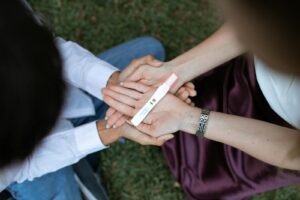
Estrogen is a hormone produced in the ovaries that controls sexual development in females. It plays a major role in the female reproductive system.1
Low estrogen levels can be normal with aging. However, in some cases, it can be caused by chronic illnesses, excessive exercise, and more.
When you have low estrogen, you might experience symptoms such as hot flashes, insomnia, and missed periods.
This article covers the causes and symptoms of low estrogen, along with how low estrogen is diagnosed and treated.
Low Estrogen Symptoms
There are several effects of low estrogen. Many of these mimic the symptoms of menopause.
Symptoms of low estrogen may include:
- Hot flashes
- Night sweats
- Insomnia
- Amenorrhea (missing periods often)
- Breast tenderness
- Headaches/Worsening migraines3
- Depression
- Difficulty concentrating
- Fatigue
- Weight gain4
- Infertility
- Painful sex due to a decrease in vaginal lubrication5
- Osteoporosis, which is the weakening of bones that can lead to fractures
- Impaired sexual development and sexual function
Causes of Low Estrogen
A woman’s estrogen levels peak in her mid- to late-20s then decline by 50% by the time she is 50.1 Estrogen declines more rapidly after menopause. Menopause is defined as 12 consecutive months without a period.
There are other conditions that can also result in low estrogen levels in females. Some of these include:
- Damage or removal of the ovaries, such as a complete hysterectomy—a surgical procedure removing the uterus and ovaries
- Excessive exercise
- Thyroid conditions
- Pituitary gland dysfunction
- Anorexia, bulimia, or other eating disorders6
- Malnutrition
- Turner syndrome, a genetic defect in which a person has only one X chromosome, instead of two sex chromosomes, which causes developmental abnormalities and infertility
- Genetic defects that cause premature ovarian failure7
- Autoimmune conditions
- Chronic (long-term) kidney disease8
- Perimenopause, the time before menopause during which estrogen levels fluctuate
- Effects of chemotherapy
Risk Factors
Age is the number one risk factor for low estrogen. As a person with ovaries approaches age 47—perimenopause age—they experience fluctuating estrogen levels for several years until full menopause.
Some other risk factors associated with low estrogen include:
- Extreme dieting or eating disorders
- Substance use disorder
- Long-term excessive exercise
- A family history of hormonal problems9
- Problems with your pituitary gland
- Cancer treatment
Diagnosis
If you have symptoms of low estrogen, your healthcare provider will likely begin a diagnostic evaluation of your symptoms. The tests your doctor selects will be determined by your symptoms, risk factors, and other medical conditions.
Diagnosis may involve:
- Family history to assess for possible genetic causes of low estrogen
- A medical history and physical examination
- Blood tests to check hormone levels
- Testing for underlying causes, such as thyroid disease or a pituitary disorder
- A brain scan
- DNA testing to evaluate genetic abnormalities of the endocrine system
Treatment
Synthetic hormone supplementation, hormone replacement therapy (HRT), is a common treatment for low estrogen in females.
There are several modes of administration your healthcare provider may choose for HRT therapy, including:
- Oral (by mouth)
- Topical (such as patches or creams)
- Injections
- Subdermal (pellets inserted under the skin)
- Vaginal
The type of HRT therapy, the mode of administration, and the dosage that you are prescribed depend on many factors. These include the underlying cause, severity, and symptoms of your low estrogen.
These are som basic facts about HRT:
- Not all people with ovaries qualify for estrogen therapy. It is contraindicated in people who have had conditions such as breast cancer, high blood pressure, heart attack, stroke, or another type of blood clot.
- There are various types of HRT available. Some combine estrogen with progesterone, another female sex hormone.
- When used for treating symptoms of menopause, estrogen alone is commonly prescribed after hysterectomy, whereas estrogen and progesterone combinations are used for people who have a uterus. Progesterone is needed to protect the uterine lining from cancerous changes that can occur when using estrogen alone.
- High doses of estrogen may be given to females who are not menopausal and who have very low estrogen levels—such as those who have had a hysterectomy— to prevent other hormonal imbalances, bone fractures, and heart disease.
- The healthcare provider usually prescribes the lowest effective dose of estrogen, or estrogen/progesterone combinations, to reduce the risk of side effects.
- There are many side effects of HRT including vaginal bleeding, leg cramps, headaches, nausea, breast tenderness, and more.
- The duration of HRT treatment depends on each person’s individual situation.
- Serious risks of HRT may involve conditions such as blood clots or cancer.
Lifestyle Changes
Sometimes lifestyle or dietary adjustments are recommended. Natural remedies for low estrogen can include:
- Maintaining a healthy weight
- Reduction of exercise if you are over-exercising
- Natural foods or supplements such as soy
Note that the use of soy or soybean isoflavones in the setting of low estrogen is controversial, according to Harvard Health.11 It’s best to speak to your healthcare provider before adding this or any supplement to your diet.
Does Vitamin D Increase Estrogen?
The hormone vitamin D supports the production of reproductive hormones in both men and women. However, more research is needed to determine if vitamin D supplementation could boost estrogen, and if so, what dose would do so effectively.12
Summary
Low estrogen levels can impact many aspects of overall health and well-being, including physical, emotional, and sexual health. They may also increase the risk of serious conditions, including heart disease, osteoporosis, and obesity.
While hormone replacement therapy is a primary treatment for low estrogen, it isn’t right for everyone. The outcome of treatment for females with low estrogen levels varies.

